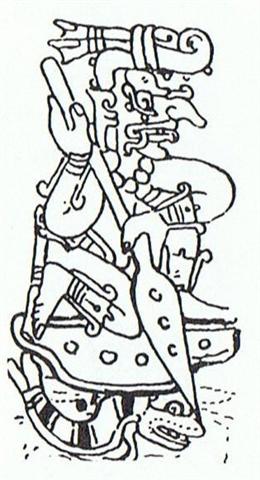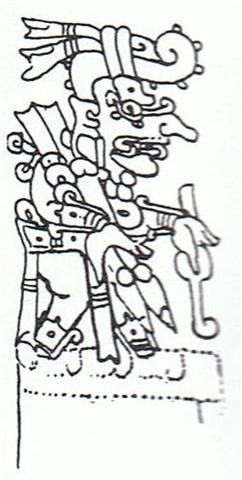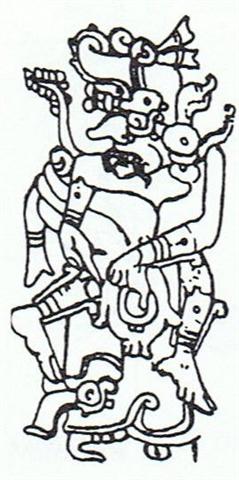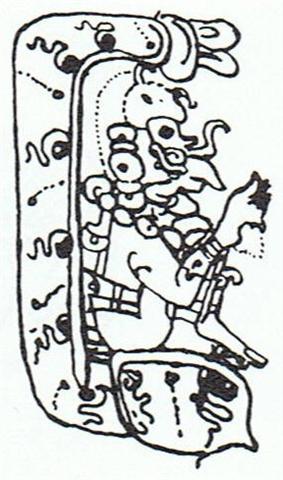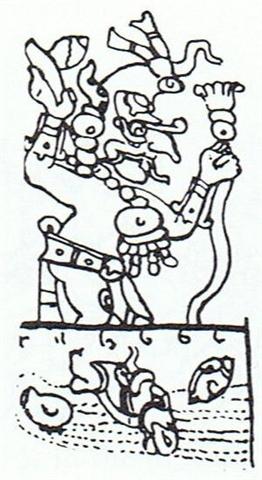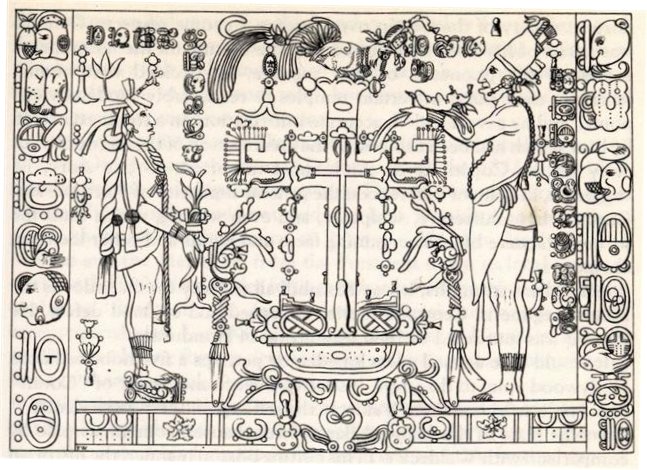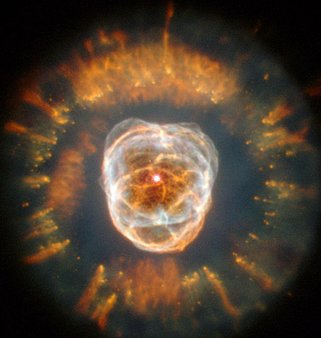There is a rising fish 107 days after 0h (resembling those 107 days from January 1 to Al Sharatain at the time of rongorongo) and a descending fish 4 days later. In between was nakshatra day 372 (January 7, possible to read as 13-7):
13 * 7 = 91 could allude to a quarter of 364 days, and 372 possibly to 3 * 72 = 216 (August 4) - and then by continuing on to Ga2-16 and Cb2-16 also to nakshatra Ana-mua:
The first 16 nights after a heliacal rising the star will not be visible, being too close to the rising Sun. 216 - 16 = 200 and 107 - 91 = 16. Once upon a time the one who died at midsummer was Hercules, a personification of the Sun as Jupiter, Father Light, the Oak. The 4th (unlucky) Rain God panel seems to illustrate what happened - he was twisted around and became one with his Tree:
A quarter of the precessional cycle ago Castor could have ruled like 'the god of the lake' and Pollux as 'the god of light' (lux) in the other half of the year, their domains being divided by a horizontal line approximately through 0h and 18h. Later this level 'water surface' went down in front and in rongorongo times (as in Roman times) the construction had turned around to become a cross. ... he aimed with an arrow at a large pochotl tree; and the arrow too was a pochotl tree, so that when he shot it through the first they formed a cross ...
Investigating all possibilities I found the Eskimo Nebula (NGC 2392) in Gemini:
"It was discovered by astronomer William Herschel in 1787. The formation resembles a person's head surrounded by a parka hood." (Wikipedia) There were approximately 100 days from Ana-tahua-vahine-o-toa-te-manava (Procyon) to Ana-tahua-taata-metua-te-tupu-mavae (Arcturus), the names of which are evidently meant to convey the idea of a woman followed by a man. ... Long ago in the very beginning of time there dwelt within a shell an infant god whose name was Ta'aroa. He was Ta'aroa the unique one, the ancestor of all gods, the creator of the universe whose natures were myriad, whose backbone was the ridgepole of the world, whose ribs were its supporters. The shell was called Rumia, Upset. Becoming aware at last of his own existence and oppressed by a yearning loneliness Ta'aroa broke open his shell and, looking out, beheld the black limitless expanse of empty space. Hopefully, he shouted, but no voice answered him. He was alone in the vast cosmos. Within the broken Rumia he grew a new shell to shut out the primeval void. Eons passed and Ta'aroa grew to be a lad conscious of his own vigor and potentialities. Impatience grew upon him until he could bear his isolation no longer. He broke forth from his shell with energy, resolved to create beings like himself who would banish his loneliness forever. Ta'aroa's first act was to construct a firm foundation for the earth, using the strong second shell for stratum rock. The shell Rumia became his dwelling place, the overarching dome of the sky. It was a confined sky enclosing the world just forming, and in its deep and abiding night the lad attained manhood. There were no Sun, Moon, or stars and only one other living creature, the Great Octopus. The sun was held down close above the slowly evolving earth by the Great Octopus, Tumu-rai-fenua, Foundation of Heaven and Earth, who lived in the primeval waters on which the earth floated. One of his arms was to the north, one to the south, one to the east and another to the west. With these vast arms he held the sky, the shell Rumia, close down against the earth. Meanwhile on the earth itself various generations of rocks were born, one after the other; then sand appeared. Roots were born and as they spread they held the sand together and the land became firm. Ta'aroa sat in his heaven above the earth and conjured forth gods with his words. When he shook off his red and yellow feathers they drifted down and became trees. He created the first parents, Tumu-nui, Great Foundation, to be the husband, and Paparaharaha, Stratum Rock, to be the wife. He put the very essence of himself into their creation; yet when he commanded them to wed, each refused to go to the other. So Ta'aroa created other gods and Atea, Bright Expanse, the Sky-goddess, who dwelt in darkness in the confined sky Rumia. By Papa-tuoi, Thin Earth, Atea was the mother of children who became artisans for Rai-tupua-nui, Great-Sky-builder. They assisted him in erecting the ten heavens above the earth. In the highest of these dwelt the god Tane, so it was called the Sky-of-the-sacred-omens of Tane and Sky-of-the-water-of-life of Tane. The next highest heaven was called Hiro's Sky-of-prophets. Atea then became the wife of Rua-tupua-nui, Source of Great Growth, and they became the parents of all the celestial beings, first the shooting stars, then the Moon and the Sun, next the comets, then the multitude of stars and constellations, and finally the bright and dark nebulae. When this tremendous task had been accomplished Atea took a third husband, Fa'a-hotu, Make Fruitful. Then occurred a curious event. Whether Atea had wearied of bringing forth offspring we are not told, but certain it is that Atea and her husband Fa'a-hotu exchanged sexes. Then the eyes of Atea glanced down at those of his wife Hotu and they begat Ru. It was this Ru who explored the whole earth and divided it into north, south, east, and west.
The redlipped Pollux here suggests a girl, but her club is a male instrument of power. |



